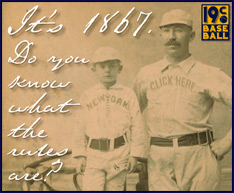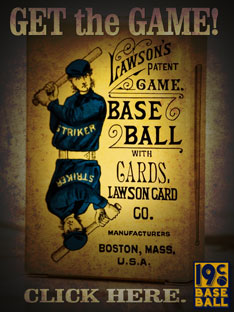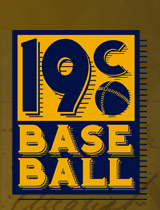History of the Strike (Continued)
1895 (NL + AA) - 1896 (NL + AA)
- A ball struck at and missed by the Batsman without its touching his bat.
- A ball legally delivered by the Pitcher that does not pass below the knee and above the shoulder and over Home Base, but not struck at by the batsman.
- An obvious attempt to make a foul hit.
- A ball struck at, if the ball touches any part of the batsman's person.
- A ball tipped by the batsman and caught by the catcher within the 10-foot lines. Now the "Foul Tip" is considered a strike. The "10-foot lines" are those forming the triangle behind home base by the first and third base foul lines extending toward the backstop and then connected.
According to David Nemec, "The enforcement of the foul bunt rule except on sacrifice attempts was the reason is the biggest reason Hugh Duffy declined so rapidly as a hitter. Even then the rule was seldom invoked unless a batter slid his hand up his bat in an obvious bunt posture. People like Willie Keeler, who choked way up on the bat, were free to continue to poke pitches foul deliberately as long as his hand positioning didn't change. My understanding is that the foul ball across the board except with two strikes was imposed in 1901 largely to eliminate the large variations among umpires as to what was a deliberate bunt attempt or effort to tap a pick foul a la Keeler and Roy Thomas."
In the 1897 rules the "Foul Tip" is defined alone.
1897 (NL + AA)
- A ball struck at and missed by the Batsman without its touching his bat.
- A ball legally delivered by the Pitcher that does not pass below the knee and above the shoulder and over Home Base, but not struck at by the batsman.
- An obvious attempt to make a foul hit.
- Any intentional effort to hit the ball to foul ground, also in the case of a "bunt hit," which sends the ball to foul ground, either directly, or by bounding or rolling from fair ground to foul ground, and which settles on foul ground.
- A ball struck at, if the ball touches any part of the batsman's person.
- A ball tipped by the batsman and caught by the catcher within ten feet from home base.
In the 1897 rules the "Foul Tip" is defined alone.
Section #3 was removed for the 1898 season since it was repeated in Section #4.
1898 (NL + AA)
- A ball struck at and missed by the Batsman without its touching his bat.
- A ball legally delivered by the Pitcher that does not pass below the knee and above the shoulder and over Home Base, but not struck at by the batsman.
- Any intentional effort to hit the ball to foul ground, also in the case of a "bunt hit," which sends the ball to foul ground, either directly, or by bounding or rolling from fair ground to foul ground, and which settles on foul ground.
- A ball struck at, if the ball touches any part of the batsman's person.
- A ball tipped by the batsman and caught by the catcher within ten feet from home base.
1899 (NL + AA) and 1900 (NL)
- A ball struck at and missed by the Batsman without its touching his bat.
- A ball legally delivered by the Pitcher that does not pass below the knee and above the shoulder and over Home Base, but not struck at by the batsman.
- Any intentional effort to hit the ball to foul ground, also in the case of a "bunt hit," which sends the ball to foul ground, either directly, or by bounding or rolling from fair ground to foul ground, and which settles on foul ground.
- A ball struck at, if the ball touches any part of the batsman's person.
- A foul tip by the Batsman, caught by the catcher while standing within the lines of his position.
The Rules: Advancing on Foul and Fair Batted Balls ![]()
The Rules of the Game: A Compilation of the Rules of Baseball 1845–1900 ![]()





